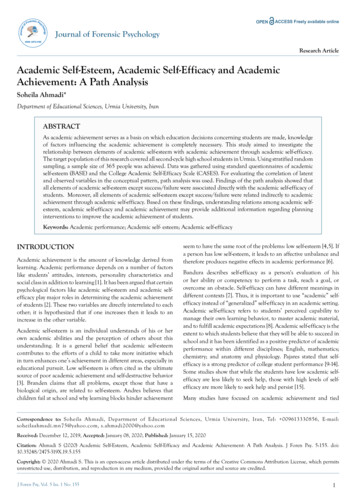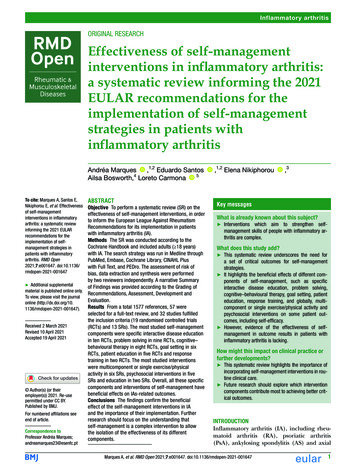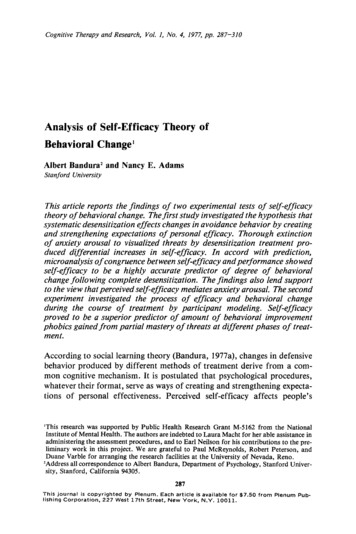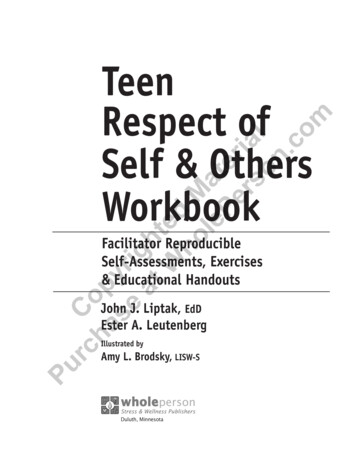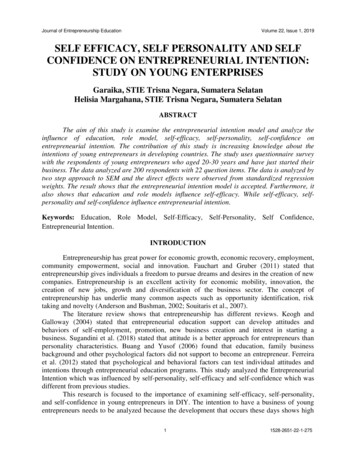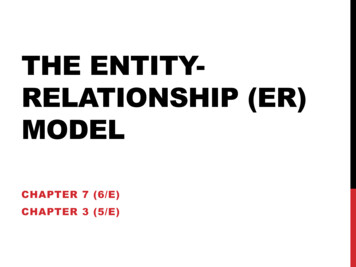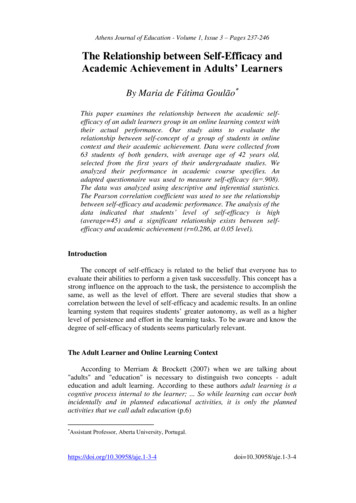
Transcription
Athens Journal of Education - Volume 1, Issue 3 – Pages 237-246The Relationship between Self-Efficacy andAcademic Achievement in Adults’ LearnersBy Maria de Fátima Goulão This paper examines the relationship between the academic selfefficacy of an adult learners group in an online learning context withtheir actual performance. Our study aims to evaluate therelationship between self-concept of a group of students in onlinecontext and their academic achievement. Data were collected from63 students of both genders, with average age of 42 years old,selected from the first years of their undergraduate studies. Weanalyzed their performance in academic course specifies. Anadapted questionnaire was used to measure self-efficacy (α .908).The data was analyzed using descriptive and inferential statistics.The Pearson correlation coefficient was used to see the relationshipbetween self-efficacy and academic performance. The analysis of thedata indicated that students’ level of self-efficacy is high(average 45) and a significant relationship exists between selfefficacy and academic achievement (r 0.286, at 0.05 level).IntroductionThe concept of self-efficacy is related to the belief that everyone has toevaluate their abilities to perform a given task successfully. This concept has astrong influence on the approach to the task, the persistence to accomplish thesame, as well as the level of effort. There are several studies that show acorrelation between the level of self-efficacy and academic results. In an onlinelearning system that requires students’ greater autonomy, as well as a higherlevel of persistence and effort in the learning tasks. To be aware and know thedegree of self-efficacy of students seems particularly relevant.The Adult Learner and Online Learning ContextAccording to Merriam & Brockett (2007) when we are talking about"adults" and "education" is necessary to distinguish two concepts - adulteducation and adult learning. According to these authors adult learning is acogntive process internal to the learner; . So while learning can occur bothincidentally and in planned educational activities, it is only the plannedactivities that we call adult education (p.6) Assistant Professor, Aberta University, Portugal.https://doi.org/10.30958/aje.1-3-4doi 10.30958/aje.1-3-4
Vol. 1, No. 3Goulão: The Relationship between Self-Efficacy Many of the learners who resort to distance learning, in general, are nolonger youths and they have their jobs and their families. Therefore, they haveto coordinate different areas of life which influence each other.The reasons that lead them to embrace a project in distance learning arequite varied. Some learners bet in getting a higher education degree, in order toachieve a better job, while others only want to increase their culture. If in amore traditional distance learning can talk in greater isolation of students, withthe introduction of information and communication technologies, the creationof online contexts such as learning support system, this situation began toreverse itself. The creation of common spaces - the virtual classroom - the useof synchronous and asynchronous communication tools enables learners andteachers a new management of learning situations. The online contexts allowgreater flexibility and diversity of formats, interactions and answers to theneeds of those who resorted to it. The virtual environment is seen as a newframework with features and elements of its own. The idea of time and spacetakes on a new perspective because it allows gathering people at various anddeferred time and spaces. Allows for constant updating and network thinking,where the non-linearity of communication is seen in different ways,individually or multi-directional.As already mentioned, the public that attends to virtual classes is typicaladult. The different changes that occur at different levels, make learning notonly occurs in a given period of time, it is increasingly required to the subject aconstant learning throughout the life cycle.The question of the specificity of the adult learner already has a few years.This issue led to the development of the movement called Andragogy, or "theart of teaching adults." The principal name that is connected to it is theMalcolm Knowles (2012). For him the adults are self-responsible and expect tohave responsibility for taking decisions.Andragogy is based on fundamental assumptions for adult learners. Let's seewhat these assumptions are.1. Self-concept of the learner. Once the adults have reached a stagewhere they have responsibility for their lives, develop apsychological need to be seen and treated by others as being ableto self-manage.2. The role of the experiment. Adults go to a learning situation witha larger number and greater diversity of experiences thanchildren.3. Orientation to learning: Adults are ready and motivated to learn.The results of this learning are related to the context of life thathelps them to deal and to solve problems.4. The need to know. Adults need to know why they have to learncertain subject before engaging in the task.5. Motivation. The best motivation is intrinsic, such as self-esteem,quality of life and an increase in employment.238
Athens Journal of EducationAugust 2014The studies of Rogers (1985) also point out to the benefits that adults canget in learning when they become responsible for it, ie, defining goals, selectsources or study materials, establish the successive steps, instill a certainrhythm and assess learning.The involvement of the adult learner in the training is part of a story, apath of personal life. The decision that takes an adult to engage in a trainingprocess is, in one way or another, connected to a personal, professional and / orsocial project. That is, the involvement of an adult learner construction leads toa formation of expectations, who may not be fully aware, but which, at the end,he expects to see realized.For Cross (1981) an adult learner invests in training, to the extent thatexpectations are so strong, and seen as important to him, that training is theway to achieve them. Thus, involvement in training mobilizes not only aspectsof cognitive order, but also, as it should be, affective aspects. Different surveysagree at one point: the individual project is the starting point for essential andindispensable that takes an individual to start a training process. That is, thisproject is the main source of energy for everything to happen.However, the involvement of an adult learner, in a training situation, maybe complicated due to the existence of other parameters. That is often the adultlearner is confronted with problems that relate to the fact that the adult hasanother type of liabilities / commitments, in addition to training. For instance,an adult may have family, business and sometimes social responsibilities.Linked to adult education we found developments in the area of selfdirected learning. In this perspective the emphasis is on the adults and on themtaking control of their learning, and the social context in which the learningtakes place it is particular important. This way of thinking about learning is oneof the most frequent choices of adults, there is a strong relation between it andself-concept.The elearning gives the student time and space flexibility, allowing a bettermanagement that suits their needs in education. In these learning systems oneof the most important roles of the teacher is being the mediator / facilitator.This means that the teacher should aim to provide appropriate educational aidto students’ constructive learning (Goulão, 2012, p.29).In an online education system, with an emphasis on the idea of a learner as aconstructor of his own knowledge, aspects related to self-regulation and selfefficacy gain particular relevance.Self-Efficacy and Academic AchievementSelf-efficacy determines how people feel, think, motivate themselves andbehave. This concept is related to the beliefs that people have about theircapacity to complete a specific task. This is constructed from the informationarriving from a range of different sources, as it can be seen in Figure 1(Bandura,1993, 1994; Bandura & Locke, 2003). So, judgments of self-efficacy239
Vol. 1, No. 3Goulão: The Relationship between Self-Efficacy result from previous experiences / accomplishments, from vicarious experience(modeled by others), from social persuasion resulting after training andevaluative feedback, and from the physical and emotional conditions of thesubjects.Figure 1. Sources of Self-efficacy InformationBeliefs about self-efficacy have a significant impact on the definition ofgoals, and compliance through the influence they exert on individually choice,motivation, resilience, and on emotional reactions. These, on the other hand,will influence the effort and persistence in performing a given task. This meansthat self-efficacy influences either the cognitive or the affective dimension ofthe learning process.However, when it comes to online contexts, the information sources mayhave other origins. The variables that influence self-efficacy in online contextsmay come either from previous successes in online systems, anxiety towardstechnology learning, feedback from teacher / trainer or frequency of a pretraining course (Stone, 1993).Bates & Khasawneh (2007) attempted to study the influence on theperception of self-efficacy in online learning, the variables that precede thelearning process and its repercussion on the expectation of result. For them thesuccesses that students obtained in the past in online contexts influence theirself-efficacy. So, they point out to the importance of adequate and prematuretraining enabling students to meet and practice the different elements that asystem of online learning provides. This point can connect to the feeling ofability to work / study / use a virtual learning system as an incorrect perceptionof this ability can influence the feeling of self-efficacy and, consequently,performance. The feedback provided by the teacher is another very importantsource of information to enhance / regulate the sense of self-efficacy.MethodObjectives240
Athens Journal of EducationAugust 2014The objectives of our research are to understand the relationship betweenthe self-efficacy’s feeling of an adults group learning in online learning contextand:a) what levels of self-efficacy do students have in a particularycourse unit;b) their performance in a particular course unit;c) sociodemographic variables, such the gender of these learners.Design and ParticipantsData collection was made through the scale of the MSLQ self-efficacyadapted. A total of 63 elearning students participated in the survey, asvolunteers; 19% males and 81% females; The average age of the participantswas 42, ranging from 25 and 60 years old (see Table 1) five students were intheir 20s, 24 students were in their 30s, 19 students were in their 40s, 14students were in their 50s, and 1 student was in his 60s. The median age was41.Table 1. Descriptive Statistics of Participansts’ AgeVariableNMINMAXAge632560AVG42.17SD8.82Material and ProcedureThe first part of the questionnaire concerned the identification of thesample (age and gender).Self-efficacy: In second part we used the scale of the MSLQ self-efficacy,adapted to the specific content and to the online environment (Appendix 1).The MSLQ was developed by a group of researchers in the University ofMichigan to improve postsecondary teaching and learning. The completeMSLQ contains 15 different sub-scales, which can be used together or singly(Pintrich et al., 1991).The questionnaire is composed by a set of 8 statements and with aresponse scale ranged between 1 and 7. Students chose a number between 1and 7 that best describes their position towards the statements. The number 1means that the student fully disagrees with the statement, and the number 7means that the student fully agrees with the statement.Overall Academic performance: Students’ overall academic performancewas measured by their total grade which could come from two different typesof evaluation. In the first group we have students with one final face to faceexam (100%); in the second group we have students with 2 criteria - two onlineworks (e-folio, 40%) during the semester and a final face to face exam (p-folio,60%)Participants were asked to complete the questionnaire online at their ownplace. The questionnaire was given once in time at the beginning of the schoolactivities of the course, before they have been requested any evaluation241
Vol. 1, No. 3Goulão: The Relationship between Self-Efficacy activity, and therefore without having had any evaluative feedback on theirperformance in that course. However, this course belonged to the 2nd semester.Figure 2 presents the overall research procedure used in this study.Figure 2. The Overall Research ProcedureData AnalysesWe proceeded to the analysis of participants' responses according to howthe questions were asked.It was the purpose of this research to examine the variables gender and agebehavior on the feeling of self-efficacy. It was also our purpose to examine therelationship between the feeling of self-efficacy and the actual performance ofthis group of students. To analyze the behavior of the variables gender, age,and performance we used the Pearson Correlation. To analyze the behavior ofthe variable gender we used the T Student test.ResultsWe will present the results taking into account the three objectives of ourresearch.Students’ Self-efficacy LevelStudents’ self-efficacy scores were analyzed to answer the first researchquestion: What levels of self-efficacy do students have in a particularly courseunit.The average score for the 8 items of the MSLQ self-efficacy scale was45.03 (SD 5.96) and the mode was 48. The reliability statistics of this scalewas α .908.Figure 3 represents minimum and maximum range of the scale of selfefficacy (Min 8; Max 56), and the Min, Max and average obtained by thestudents (45).Figure 3. Representation of the Min, Max and Average Student Relatively tothe Theoretical Minimum and Maximum Values on the Scale of Self-Efficacy242
Athens Journal of EducationAugust 2014We will now present the results obtained in our study regarding the 8questions of scale of self-efficacy by comparing them to the results obtained inthe investigation of Pintrinch at al (1991).Table 2. Comparing Descriptive Statistic from Pintrinch at Al (1991) and thisStudyVariableSelfefficacyPintrinch et alAVGSDαAVGThis 908Self-efficacy and Final ClassificationAs we said earlier, we will now proceed to present the results obtainedregarding the relationship between self-efficacy and the final classification (seeFigure 3)Figure 3. Relationship between Self-Efficacy and ClassificationThe results for self-efficacy were presented in the previous section.243
Vol. 1, No. 3Goulão: The Relationship between Self-Efficacy The 63 students had an average final classification of 13.40 (SD 3.69) ona scale of 0 to 20. The median was 15 and the mode was 16.As can be seen the average level of self-efficacy of these students isreasonably high. To check the possible relationship between these twovariables we used the Pearson correlation coefficient. The result (rpb .286)indicates a statistically significant relationship between the sense of selfefficacy indicated by these students and their level of academic performance, inthis particular course. This correlation is significant at the .05 level.Self-efficacy and GenderWe now present the results obtained for these two socio-demographicvariables, beginning by analyzing the gender variable. To check if there aredifferences between men and women regarding self-efficacy we used the TStudent test. The results obtained are shown in Table 2.Table 2. Results for the T Test by GenderMen(n 12)Mean (SD)Self-efficacy (total45.92 (7.01)score)Women(n 51)Mean (SD)t (63)44.73 (5.73)-.546 (ns)The result from applying Pearson correlation test indicates that there areno statistically significant differences between men and women regarding selfefficacy. The results (rpb - .073) in the correlation analysis between thevariable gender and self-efficacy indicate an absence of a statisticallysignificant correlation between them.ConclusionsOur aim was, first, to analyze the level of self-efficacy do students have ina particularly course unit. Our results indicate a high level of self-efficacy inour sample. In addition, although we used a modified version of the MSLQself-efficacy scale, the psychometric characteristics are in agreement with thevalues found in the original scale.Secondly, to analyze the relationship between self-efficacy beliefs and theperformance of a group of students in a particular course in the context ofvirtual learning. Finally, to examine these beliefs of self-efficacy based ongender. Our results point out of a statistically significant relationship betweenthe self-efficacy and performance. These results seem to go in the same way tothe other studies that usually find out a statistically significant relationshipbetween performance and self-efficacy (Bates & Khasawneh, 2007; Cascio etal, 2013; Taipjutorus, Hansen & Brown, 2012). Regarding to our third goallinked to gender, the results do not indicate statistically significant differencesbetween men and women in self-efficacy in this specific content and in a244
Athens Journal of EducationAugust 2014virtual learning system. These results do not meet some studies that indicatestatistically significant differences between gender when it comes to selfefficacy associated with the use of computers or the internet (Eachus &Cassidy, 2006), reinforcing the stereotype that Internet users are generallyperceived as young and males. There are also other studies that foundstatistically significant differences between men and women when using thevirtual space (Goulão 2013).Despite the limitations of this study we must take into account the resultsobtained in what comes to the relationship between self-efficacy andperformance of students. For this, we reiterate the importance of how virtuallearning environments should be designed. These should provide positiveexperiences and to help the student to enhance their capacity for self-learning,self-regulated learning and motivation in the face of formal learning situations.The teacher has an important role in defining / reorganization of the tasksof learning and formative assessment providing to the student appropriatefeedback to their situation, to help them overcome difficulties, enhancing theirskills, not only in terms of specific content matter, but also to the use of virtuallearning environments potential.For this reason, we would like to reinforce the important role that thepreconditions have to start learning a course related to the acquisition /enhancement of skills in the use of technology and field of ways of workingand interacting in these spaces to an increased feeling of self-efficacy in thiscontext. This can be a facilitator of learning relationships between subjects,content and environment resulting in better performance.ReferencesBandura,A, 1994. Self-efficacy. In Ramachaudran,V.S. (Ed.), Encyclopedia of humanbehavior (vol.4, pp.71-81). New York: Academic PressBandura,A,1993. Perceived self-efficacy in cognitive development and functioning.Educational Psychologist, 28(2),117-148Bandura,A. & Locke,E. 2003. Negative self-efficacy and goal effects revisited.Journal of Applied Psychology, 88 (1),87 - 99Bates, R. & Khasawneh, S. 2007. Self-efficacy and college students’ perceptions anduse of online learning systems. Computers in Human Behavior, 23, 175-191Cascio M., Botta V., Anzaldi V. 2013. The role of self-efficacy and internal locus ofcontrol in online learning. Journal of e-Learning and Knowledge Society, v.9,n.3, 95-106Cross,K.P. 1981. Adults as learners, San Francisco, Jossey-BassDeTure,M. 2004. Cognitive style and self-efficacy:Predicting student sucess in onlinedistance education. The American Journal of Distance Education, 18(1), 21-38Eachus,P. & Cassidy, S. 2006. Development of the Web Users Self-Efficacy Scale(WUSE). Issues in Informing Science and Information Technology, 3, 199 - 209Goulão, Mª Fátima 2013. Virtual learning styles: does gender matter? Procedia –Socail and Behavioral Sciences, 106, 3345 - 3354245
Vol. 1, No. 3Goulão: The Relationship between Self-Efficacy Goulão, Mª Fátima 2012. Ensinar e Aprender em ambientes online: Alterações eContinuidades na(s) prática(s) docente(s). In Moreira, J.A. & Monteiro, A. (orgs).Ensinar e Aprender Online com Tecnologias Educativas (pp.15-30). Porto: PortoEditoraGoulão, Mª Fátima 2010. Distance Learning - A Strategy for Lifelong Learning. InGregory Papanikos & Nicholas Pappas. Horizons in Education (pp.55 – 65).Atenas: ATINERKnowles, M. Holton,E. & Swanson, R. 2012. The adult learner. New York: RoutledgeMerriam,S. & Brockett,R. 2007. The profession and practice of adult education. SanFrancisco: Jossey-BassPintrich, P. R., Smith, D. A., Garcia, T., & McKeachie, W. K. (1991). A manual forthe use of the Motivated Strategies for Learning Questionnaire(MSLQ).University of Michigan.Rogers,C.R. 1985.Tornar-se pessoa, Lisboa, Moraes EditoresStone, D.1993. Overconfidence in Initial Self-Efficacy Judgments: Effects onDecision Processes and Performance. Organizational Behavior and HumanDecision Processes, 59 (3), 452-474Taipjutorus, W., Hansen, S., & Brown, M. 2012. Investigating a Relationship betweenLearner Control and Self-efficacy in an Online Learning Environment. Journal ofOpen, Flexible, and Distance Learning, 16(1), 56 - 69Zimmerman,B. 2000. Self-Efficacy: An Essential Motive to Learn. ContemporaryEducational Psychology 25, 82–91Appendix A. Self-efficacy Questions (adapted from MSLQ, Pintrinch et al, 1991)Sub-scaleSelf-efficacyQuestion Item1. I believe I will receive an excellent score on thisseminar after learning about this topic in thisonline learning context.2. I’m certain I can understand difficult materialabout Education and Literacy presented in thisonline learning context.3. I’m confident I can understand basic conceptsabout Education and Literacy presented in thisonline learning context.4. I’m confident I can understand the mostcomplex material about the Education andLiteracy presented in this online learningcontext.5. I’m confident I can do an excellent job inmeeting the goal for this task of learning aboutEducation and Literacy.6. I expect to do well learning about Education andLiteracy with this online learning context.7. I’m certain I can master the material onEducation and Literacy presented in this onlinelearning context.8. Considering the difficulty of the material ofEducation and Literacy, the learning context,and my skills, I think I will do well.246
efficacy and academic achievement (r 0.286, at 0.05 level). Introduction The concept of self-efficacy is related to the belief that everyone has to evaluate their abilities to perform a given task successfully. This concept has a strong influence on the approach to the task, the persistence to accomplish the

